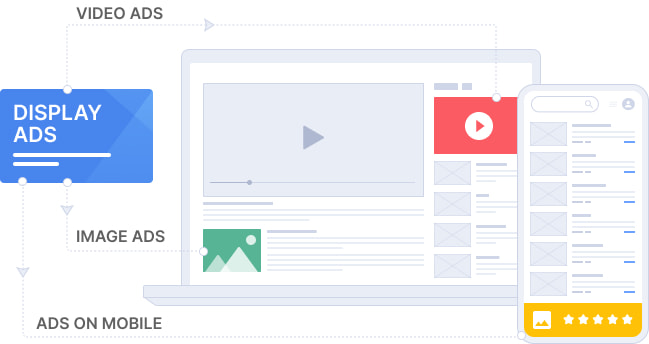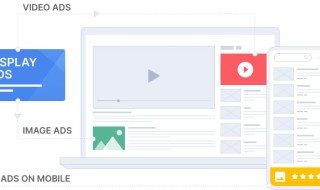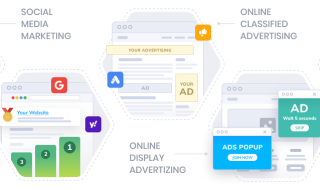
In the vast, visually-driven world of the internet, simply having a great product or a compelling message isn't enough. You need to be seen. Display advertising online is a powerful and essential tool for capturing attention, building brand awareness, and driving growth. Far from being just simple "banner ads," modern display advertising is a sophisticated ecosystem of targeting, creativity, and data-driven strategy.
For businesses looking to thrive in 2025, mastering display advertising is not optional—it's a critical component of a robust digital marketing plan. This in-depth guide will walk you through everything you need to know to create, launch, and manage successful display advertising campaigns that deliver a real return on investment (ROI).
What is Display Advertising Online?
Display advertising refers to the visual ads you see across the internet on websites, apps, and social media platforms. Unlike search ads, which appear when a user actively searches for a keyword, display ads are presented to users as they browse other content. They come in various formats, including:
- Static banner ads: Traditional image-based ads.
- Animated GIFs: Simple, looping animations.
- HTML5 ads: Interactive and dynamic ads that can include complex animations and interactive elements.
- Video ads: Short video clips that play within a banner space or as interstitials.
The primary goal of display advertising has evolved. While it remains a cornerstone for building top-of-funnel brand awareness, advanced targeting and analytics have transformed it into a powerful tool for driving conversions and direct sales.
The Foundation of Success: Setting Clear Objectives
Before you design a single ad or spend a dollar, you must define what success looks like. Your campaign's objectives will dictate your strategy, targeting, creative, and key performance indicators (KPIs).
- Brand Awareness: The goal is to introduce your brand to a new, broad audience. Success is measured by metrics like impressions, reach, and viewability.
- Lead Generation: The aim is to capture contact information from potential customers. KPIs include click-through rate (CTR), cost per lead (CPL), and conversion rate on your landing page.
- Sales and Revenue: The objective is to drive direct purchases. Success is measured by return on ad spend (ROAS), cost per acquisition (CPA), and total conversion value.
The Power of Precision: Mastering Ad Targeting
The single most important factor for success in display advertising online is getting your ads in front of the right people. Today's platforms offer a granular suite of targeting options that allow you to move beyond broad demographics and reach users based on their specific behaviors and interests.
1. Contextual Targeting: Placing Ads in Relevant Environments
Contextual targeting places your ads on web pages whose content is relevant to your product or service. This is a privacy-friendly approach that aligns your message with what the user is actively consuming.
- Keyword Targeting: Your ads appear on pages that contain specific keywords you've chosen. For example, a company selling hiking boots could target pages with keywords like "best hiking trails" or "outdoor gear reviews."
- Topic Targeting: You select from broad categories of content, such as "Travel," "Automotive," or "Finance," to have your ads appear on websites within those topics.
2. Audience Targeting: Reaching Specific Types of People
Audience targeting focuses on the user's characteristics and digital footprint, regardless of the specific page they are viewing.
- Affinity Audiences: Reach users based on their long-term interests and hobbies, such as "Foodies" or "DIY Enthusiasts." This is great for building brand awareness.
- In-Market Audiences: Target users who are actively researching and considering purchasing products or services like yours. This is a powerful tool for driving conversions.
- Demographic Targeting: Target based on age, gender, parental status, and in some regions, household income.
3. The Ultimate Weapon: Retargeting (Remarketing)
Retargeting is the practice of showing ads to users who have already interacted with your website or app. These are warm leads who are familiar with your brand, making them much more likely to convert.
- Standard Retargeting: Show ads to all recent website visitors.
- Dynamic Retargeting: Show hyper-personalized ads that feature the exact products a user viewed or added to their cart. This is incredibly effective for e-commerce.
- Sequential Retargeting: Tell a story by showing a sequence of different ads to a user over time to guide them through the sales funnel.
- Cart Abandonment Retargeting: Specifically target users who added items to their cart but didn't complete the purchase. Often, a simple reminder or a small incentive like "free shipping" is enough to bring them back.
Designing Ads That Convert: Creative Best Practices
In a sea of digital content, your ad has only a split second to capture attention. This is where creative excellence becomes paramount.
The Anatomy of a High-Performing Display Ad
- A Compelling Value Proposition: Clearly and concisely communicate the main benefit. Why should someone care? What problem do you solve? Don't list features; highlight the outcome.
- Eye-Catching Imagery or Animation: Use high-quality, relevant images or smooth, purposeful animation (if using HTML5). Avoid generic stock photos. Authentic, relatable visuals perform best.
- Your Brand Logo: Your logo should be clearly visible but not overpowering. The goal is to build brand recall.
- A Strong Call-to-Action (CTA): This is the most critical element. Tell the user exactly what you want them to do next. Use action-oriented language like "Shop Now," "Get Your Free Guide," or "Book a Demo." Make your CTA a distinct, clickable button.
Tips for Combating "Banner Blindness"
Users have become adept at subconsciously ignoring things that look like ads. To break through:
- Use Non-Standard Placements: Test placements outside of the traditional top-of-page and right-sidebar positions.
- Incorporate Subtle Animation: Motion can draw the eye, but avoid rapid, flashing animations that feel spammy. Smooth, elegant transitions are key.
- Leverage Native Advertising: Use ads that are designed to match the look and feel of the website they appear on, making them feel more like part of the content.
- Be Bold and Simple: A clean, uncluttered design with a strong visual hierarchy is often more effective than a busy, complex ad.
The Post-Click Experience: Optimizing Your Landing Page
Your ad's job is to get the click. Your landing page's job is to get the conversion. A seamless transition is crucial.
- Message Match: The headline, offer, and imagery on your landing page must directly match the ad that the user clicked. A disconnect will lead to immediate bounces.
- Singular Focus: A good landing page has one goal and one corresponding CTA. Remove all distractions, including site navigation menus and unnecessary links.
- Mobile-First Design: The majority of display ad traffic will come from mobile devices. Your landing page must be fast-loading and easy to navigate on a small screen.
- Build Trust: Include social proof like customer testimonials, reviews, or trust seals to reassure visitors and reduce friction.
Measuring What Matters: Tracking Your Success
To optimize your campaigns and prove their value, you must track the right metrics.
- Impressions: The number of times your ad was served. (Awareness)
- Click-Through Rate (CTR): The percentage of impressions that resulted in a click. (Ad Relevance/Engagement)
- Cost Per Click (CPC): How much you pay for each click. (Efficiency)
- Conversion Rate: The percentage of clicks that resulted in a desired action (e.g., a sale or lead). (Landing Page & Offer Effectiveness)
- Cost Per Acquisition (CPA): The total cost to acquire one customer. (Profitability)
- Return on Ad Spend (ROAS): The total revenue generated for every dollar spent. (The ultimate measure of success for e-commerce)
Don't Forget View-Through Conversions (VTCs)
A VTC is recorded when a user sees your ad, doesn't click it, but later visits your website and converts through another channel (like organic search or by typing your URL directly). This metric is crucial for understanding the true brand-building impact of your display advertising online, as it shows that the ad influenced a future action even without a direct click.
Your Partner in Digital Growth
Succeeding with display advertising online in 2025 requires a strategic blend of art and science. It demands precise targeting, compelling creative, a frictionless user experience, and continuous data-driven optimization. By setting clear goals, understanding your audience, and adhering to best practices, you can transform display advertising from a simple line item in your budget into a powerful engine for business growth.
At Webxloo, we specialize in crafting sophisticated digital advertising strategies that deliver measurable results. Our team of experts can help you navigate the complexities of display advertising, from initial strategy and creative design to campaign management and in-depth analytics, ensuring your message not only gets seen but gets results.



 Phone Consultation
Phone Consultation
 Request a quote
Request a quote
 Text a Message
Text a Message